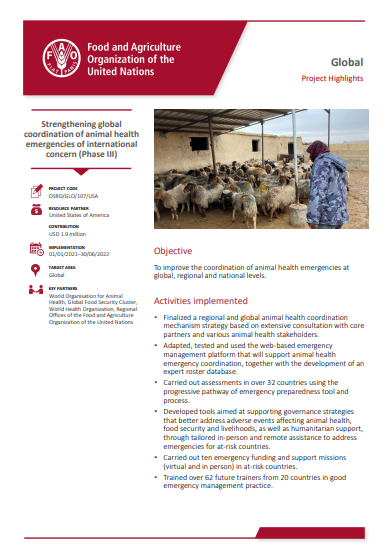Publications

Niger: Humanitarian Response Plan 2023
03/2023
In the Niger, persistent conflict, droughts, floods and increased staple food prices have aggravated vulnerable households’ food insecurity.

Tajikistan: Mitigating the locust spread in Tajikistan and neighbouring countries through Anticipatory Action
03/2023
In March–April 2022, the Republic of Tajikistan witnessed an increase of Moroccan locust infestations in its southern areas, and the infestation threatened the bordering regions of Afghanistan.

Ukraine: Response programme, January–December 2023
03/2023
The war in Ukraine is significantly impacting food security at the national and global levels. Without urgent support to the Ukrainian agrifood sector, humanitarian needs will continue to rise and the stability of global food value chains will remain under threat.

Pakistan: Floods response update, February 2023
03/2023
Rural communities of Pakistan were among the hardest hit by the devastating floods of June–August 2022.

Mozambique: Humanitarian Response Plan 2023
03/2023
This document provides an overview of FAO's component of the 2023 Humanitarian Response Plan for Mozambique.

Haiti: Humanitarian Response Plan 2023
03/2023
Nearly half of the population in Haiti doesn’t have enough to eat, including for the first time ever 19 200 people in Catastrophe (IPC Phase 5).

Syrian Arab Republic: Humanitarian Response Plan 2023
03/2023
With the conflict now in its thirteenth year, the Syrian Arab Republic continues to face insecurity, economic crisis, drought-like conditions and severe agroclimatic fluctuations.

Mozambique: DIEM – Data in Emergencies Monitoring brief, round 4
02/2023
Results and recommendations, February 2023

Guatemala: DIEM – Data in Emergencies Monitoring brief, round 1
02/2023
Results and recommendations, February 2023

Yemen: Project Highlights - OSRO/YEM/006/KSC
02/2023
The protracted nature of the crisis in Yemen has decimated the livelihoods of vulnerable agriculture-dependent households; and the COVID-19 pandemic has compounded their vulnerabilities.

Somalia: Project Highlights - OSRO/SOM/106/USA
02/2023
The Government of the United States of America contributed USD 22.5 million to the FAO project, "Improved food security and livelihood recovery in Somalia".

Global: Project Highlights - OSRO/GLO/107/USA
02/2023
The United States of America funded the project OSRO/GLO/107/USA for a total of USD 1.9 million.

Niger: DIEM – Data in Emergencies Monitoring brief, round 5
02/2023
This Data in Emergencies Monitoring (DIEM-Monitoring) brief shares the results of a fifth-round assessment conducted between November and December 2022 in Niger.

Sierra Leone: DIEM – Data in Emergencies Monitoring brief, round 8
02/2023
This Data in Emergencies Monitoring (DIEM-Monitoring) brief shares the results of an eighth-round field assessment conducted between October and December 2022 in Sierra Leone.

Iraq: DIEM – Data in Emergencies Monitoring brief, round 8
02/2023
This Data in Emergencies Monitoring (DIEM-Monitoring) brief shares the results of an eighth-round assessment conducted between July and August 2022 in Iraq.

Drought in the Horn of Africa: Progress report on the rapid response and mitigation plan to avert a humanitarian catastrophe (January–December 2022)
02/2023
This progress report details FAO’s work to mitigate the impact of the worst drought in 40 years on food security and livelihoods in the Horn of Africa in 2022.

Uganda: Germany’s contribution through the Special Fund for Emergency and Rehabilitation Activities (SFERA) – Anticipatory Action window
02/2023
Since 2019, Uganda’s Karamoja subregion has suffered from progressive food insecurity as a result of below-average crop and livestock production due to erratic weather conditions, plant pests and animal diseases, and price shocks.

The Sudan: Project Highlights - OSRO/SUD/114/USA
02/2023
As a result of devasting floods in 2020, the livelihoods of farming and livestock keeping households across the Sudan were severely disrupted.

Somalia: Project Highlights - OSRO/SOM/104/JPN
02/2023
Maritime security and youth empowerment in Somali fisheries.

Mongolia: Belgium’s contribution through the Special Fund for Emergency and Rehabilitation Activities (SFERA) – Anticipatory Action window
01/2023
In Mongolia, the frequency, intensity and unpredictability of weather extremes such as the harsh winter (dzud), drought, snow and dust storms, heavy rainfall and flooding have tripled in the last decade, heavily impacting traditional livestock-based livelihoods.
